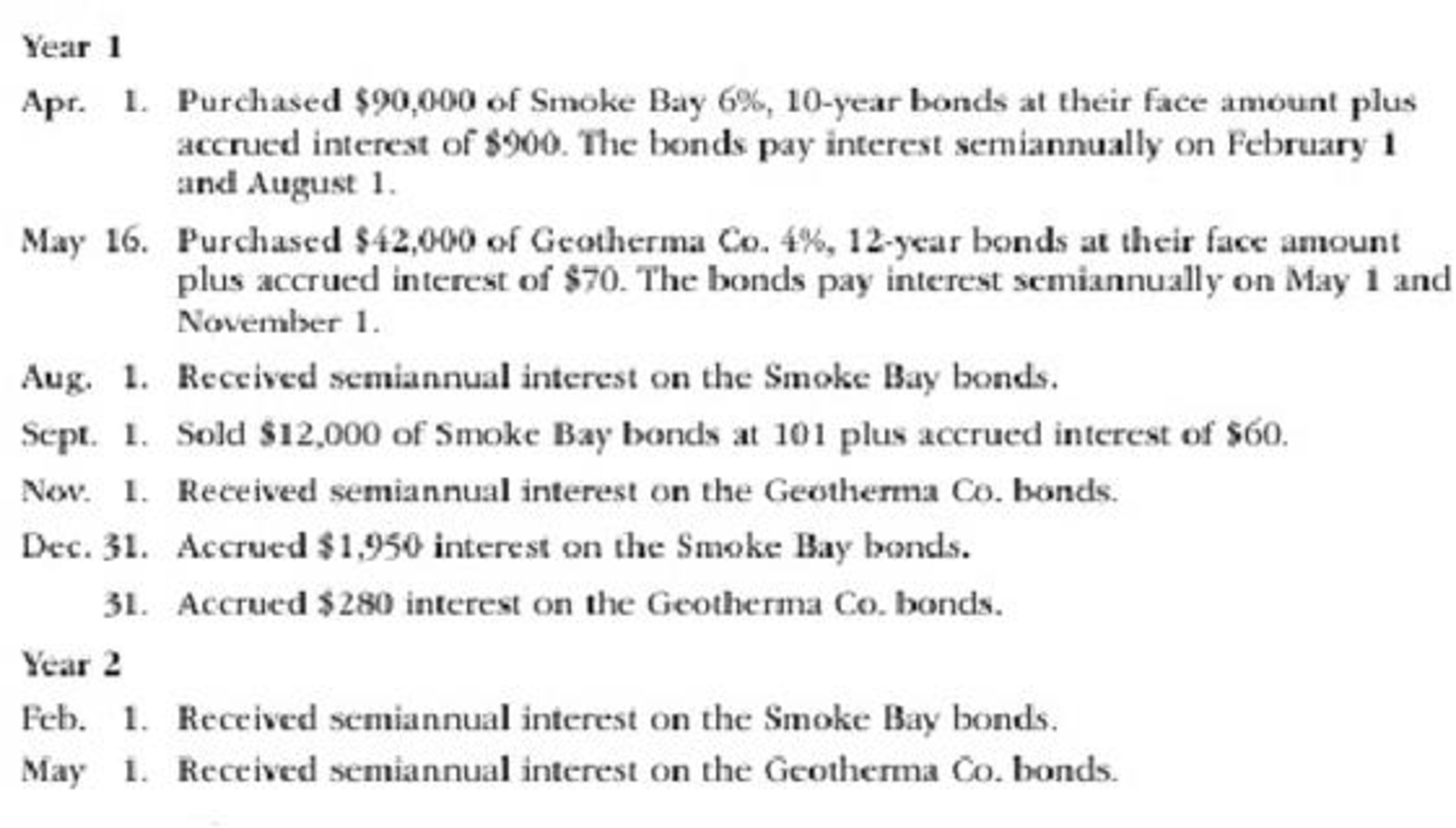
Rekya Mart Inc. is a general merchandise retail company that began operations on January 1, Year 1. The following transactions relate to debt investments acquired by Rekya Mart Inc., which has a fiscal year ending on December 31:

Instructions
- 1.
Journalize the entries to record these transactions. - 2. If the bond portfolio is classified as available for sale, what impact would this have on financial statement disclosure?
(1)
Journalize the bond investment transactions in the books of Company RM.
Explanation of Solution
Bond investment: Bond investments are debt securities which pay a fixed interest revenue to the investor.
Journal entry: Journal entry is a set of economic events which can be measured in monetary terms. These are recorded chronologically and systematically.
Debit and credit rules:
- Debit an increase in asset account, increase in expense account, decrease in liability account, and decrease in stockholders’ equity accounts.
- Credit decrease in asset account, increase in revenue account, increase in liability account, and increase in stockholders’ equity accounts.
Prepare journal entry for purchase of $100,000 bonds of Company SB, at face amount with an accrued interest of $900.
| Date | Account Titles and Explanations | Post. Ref. | Debit ($) | Credit ($) | |
| Year 1 | |||||
| April | 1 | Investments–Company SB Bonds | 90,000 | ||
| Interest Receivable | 900 | ||||
| Cash | 90,900 | ||||
| (To record purchase of Company SB bonds for cash) | |||||
Table (1)
- Investments–Company SB Bonds is an asset account. Since bonds investments are purchased, asset value increased, and an increase in asset is debited.
- Interest Receivable is an asset account. Since interest to be received has increased, asset value increased, and an increase in asset is debited.
- Cash is an asset account. Since cash is paid, asset account decreased, and a decrease in asset is credited.
Prepare journal entry for purchase of $210,000 bonds of Company B, at face amount with an accrued interest of $700.
| Date | Account Titles and Explanations | Post. Ref. | Debit ($) | Credit ($) | |
| Year 1 | |||||
| May | 16 | Investments–Company G Bonds | 42,000 | ||
| Interest Receivable | 70 | ||||
| Cash | 42,070 | ||||
| (To record purchase of Company G bonds for cash) | |||||
Table (2)
- Investments–Company G Bonds is an asset account. Since bonds investments are purchased, asset value increased, and an increase in asset is debited.
- Interest Receivable is an asset account. Since interest to be received has increased, asset value increased, and an increase in asset is debited.
- Cash is an asset account. Since cash is paid, asset account decreased, and a decrease in asset is credited.
Prepare journal entry to record the interest revenue received from Company SB bonds.
| Date | Account Titles and Explanations | Post. Ref. | Debit ($) | Credit ($) | |
| Year 1 | |||||
| August | 1 | Cash | 2,700 | ||
| Interest Receivable | 900 | ||||
| Interest Revenue | 1,800 | ||||
| (To record receipt of interest revenue) | |||||
Table (3)
- Cash is an asset account. Since cash is received, asset account increased, and an increase in asset is debited.
- Interest Receivable is an asset account. Since interest to be received is received, asset value decreased, and a decrease in asset is credited.
- Interest Revenue is a revenue account. Since revenues increase equity, equity value is increased, and an increase in equity is credited.
Working Notes:
Compute amount of interest received from Company SB.
Prepare journal entry for $12,000 bonds of Company SB sold at 101%, with an accrued interest of $60.
| Date | Account Titles and Explanations | Post. Ref. | Debit ($) | Credit ($) | |
| Year 1 | |||||
| September | 1 | Cash | 12,180 | ||
| Interest Revenue | 60 | ||||
| Gain on Sale of Investments | 120 | ||||
| Investments–Company SB Bonds | 12,000 | ||||
| (To record sale of Company SB bonds) | |||||
Table (4)
- Cash is an asset account. Since cash is received, asset account increased, and an increase in asset is debited.
- Interest Revenue is a revenue account. Since revenues increase equity, equity value is increased, and an increase in equity is credited.
- Gain on Sale of Investments is an income account. Since income increases equity, equity value is increased, and an increase in equity is credited.
- Investments–Company SB Bonds is an asset account. Since bond investments are sold, asset value decreased, and a decrease in asset is credited.
Working Notes:
Calculate the cash received from the sale of bonds.
| Particulars | Amount ($) |
| Cash proceeds from sale of $12,000 bonds | 12,120 |
| Add: Accrued interest revenue | 60 |
| Cash received | $12,180 |
Table (5)
Calculate the realized gain (loss) on sale of $40,000 bonds.
| Particulars | Amount ($) |
| Cash proceeds from sale of $12,000 bonds | 12,120 |
| Cost of bonds sold | (12,000) |
| Gain (loss) on sale of bonds | $120 |
Table (6)
Prepare journal entry to record the interest revenue received from Company G bonds.
| Date | Account Titles and Explanations | Post. Ref. | Debit ($) | Credit ($) | |
| Year 1 | |||||
| November | 1 | Cash | 840 | ||
| Interest Receivable | 70 | ||||
| Interest Revenue | 770 | ||||
| (To record receipt of interest revenue) | |||||
Table (7)
- Cash is an asset account. Since cash is received, asset account increased, and an increase in asset is debited.
- Interest Receivable is an asset account. Since interest to be received is received, asset value decreased, and a decrease in asset is credited.
- Interest Revenue is a revenue account. Since revenues increase equity, equity value is increased, and an increase in equity is credited.
Working Notes:
Compute amount of interest received from Company G.
Prepare journal entry for accrued interest.
| Date | Account Titles and Explanations | Post. Ref. | Debit ($) | Credit ($) | |
| Year 1 | |||||
| December | 31 | Interest Receivable | 1,950 | ||
| Interest Revenue | 1,950 | ||||
| (To record interest accrued) | |||||
Table (8)
- Interest Receivable is an asset account. Since interest to be received has increased, asset value increased, and an increase in asset is debited.
- Interest Revenue is a revenue account. Since revenues increase equity, equity value is increased, and an increase in equity is credited.
Prepare journal entry for accrued interest.
| Date | Account Titles and Explanations | Post. Ref. | Debit ($) | Credit ($) | |
| Year 1 | |||||
| December | 31 | Interest Receivable | 280 | ||
| Interest Revenue | 280 | ||||
| (To record interest accrued) | |||||
Table (9)
- Interest Receivable is an asset account. Since interest to be received has increased, asset value increased, and an increase in asset is debited.
- Interest Revenue is a revenue account. Since revenues increase equity, equity value is increased, and an increase in equity is credited.
Prepare journal entry to record the interest revenue received from Company SB bonds.
| Date | Account Titles and Explanations | Post. Ref. | Debit ($) | Credit ($) | |
| Year 2 | |||||
| February | 1 | Cash | 2,340 | ||
| Interest Receivable | 1,950 | ||||
| Interest Revenue | 390 | ||||
| (To record receipt of interest revenue) | |||||
Table (9)
- Cash is an asset account. Since cash is received, asset account increased, and an increase in asset is debited.
- Interest Receivable is an asset account. Since interest to be received is received, asset value decreased, and a decrease in asset is credited.
- Interest Revenue is a revenue account. Since revenues increase equity, equity value is increased, and an increase in equity is credited.
Working Notes:
Compute amount of interest received from Company SB.
Prepare journal entry to record the interest revenue received from Company G bonds.
| Date | Account Titles and Explanations | Post. Ref. | Debit ($) | Credit ($) | |
| Year 2 | |||||
| May | 1 | Cash | 840 | ||
| Interest Receivable | 280 | ||||
| Interest Revenue | 560 | ||||
| (To record receipt of interest revenue) | |||||
Table (10)
- Cash is an asset account. Since cash is received, asset account increased, and an increase in asset is debited.
- Interest Receivable is an asset account. Since interest to be received is received, asset value decreased, and a decrease in asset is credited.
- Interest Revenue is a revenue account. Since revenues increase equity, equity value is increased, and an increase in equity is credited.
Working Notes:
Compute amount of interest received from Company G.
(2)
Explain the impact of bonds, if the portfolio is classified as available-for-sale investment.
Explanation of Solution
Available-for-sale investments are reported at fair value. If the bond portfolio is classified as available-for-sale investment, the bond portfolio should be reported at fair value. The changes in the cost and fair value would be adjusted using the valuation account and unrealized gain (loss) account.
Want to see more full solutions like this?
Chapter 15 Solutions
Financial Accounting
- I need help with this general accounting problem using proper accounting guidelines.arrow_forwardI need help finding the accurate solution to this general accounting problem with valid methods.arrow_forwardPlease provide the solution to this general accounting question with accurate financial calculations.arrow_forward
- Please explain the solution to this general accounting problem using the correct accounting principles.arrow_forwardI am looking for the correct answer to this financial accounting problem using valid accounting standards.arrow_forwardI am looking for the correct answer to this general accounting problem using valid accounting standards.arrow_forward
- Please provide the solution to this financial accounting question with accurate financial calculations.arrow_forwardI am looking for the correct answer to this general accounting problem using valid accounting standards.arrow_forwardCan you solve this financial accounting question with the appropriate financial analysis techniques?arrow_forward
 Financial AccountingAccountingISBN:9781337272124Author:Carl Warren, James M. Reeve, Jonathan DuchacPublisher:Cengage Learning
Financial AccountingAccountingISBN:9781337272124Author:Carl Warren, James M. Reeve, Jonathan DuchacPublisher:Cengage Learning Cornerstones of Financial AccountingAccountingISBN:9781337690881Author:Jay Rich, Jeff JonesPublisher:Cengage Learning
Cornerstones of Financial AccountingAccountingISBN:9781337690881Author:Jay Rich, Jeff JonesPublisher:Cengage Learning

